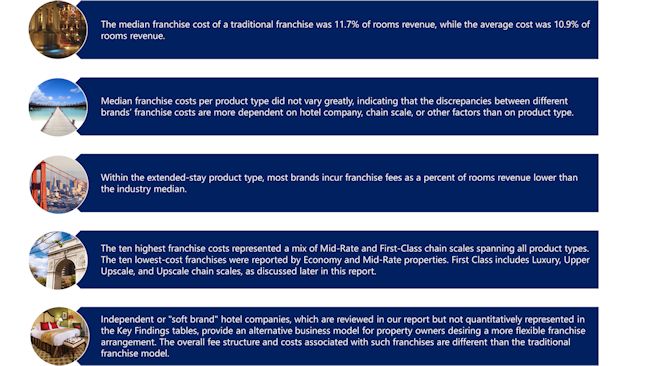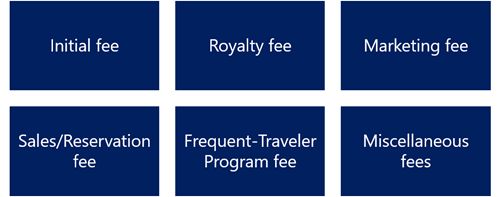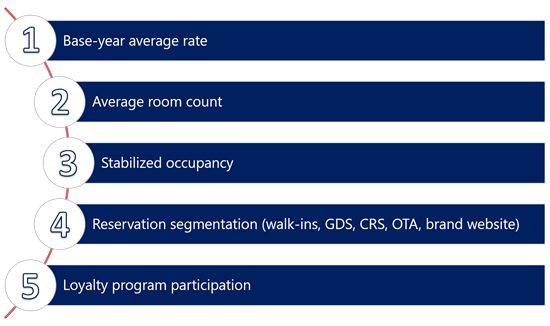
The selection of an appropriate franchise affiliation affects a property’s ability to compete in its local market, generate profits, and achieve a desirable image and market orientation.
By Kasia M. Russell and Bomie Kim
The HVS U.S. Hotel Franchise Fee Guide provides a comparative review of various hotel franchises based on their applicable franchise fees. The selection of an appropriate franchise affiliation affects a property’s ability to compete in its local market, generate profits, and achieve a desirable image and market orientation. Because the success of a hotel is based primarily on the cash flow generated, owners and lenders must weigh the benefits of a brand affiliation against the total cost of such a commitment.
Please note that the study results are not indicative of the impact an individual brand may have on a hotel’s overall profitability because only the costs and not the benefits of the franchise affiliations have been analyzed. Furthermore, the study does not reflect, nor does it claim to address, operating results of any one particular brand or any particular brand affiliation upon any single hotel property. This 2015/16 U.S. Franchise Fee Guide is meant to illustrate a basic comparison among franchise fees charged by participants.
HVS has extensive experience in assisting clients in selecting the appropriate franchise and/or management brand for their proposed or exiting hotels. This service also includes assisting with or managing the negotiations in coordination with experienced attorneys and other industry professionals.
The Guide encompasses the following key findings:
(Click to Enlarge)
Methodology and Assumptions
Historically, this guide subjected each brand’s criteria to a broader and uniform set of assumptions. However, the 2014 guide and subsequent updates have been reengineered to consider each brand’s own unique set of variables.
HVS collected the Franchise Disclosure Documents (FDDs) from 69 hotel brands and then analyzed the sections pertaining to the costs associated with being a franchisee. Since the Federal Trade Commission regulates the sale of franchises, information regarding each franchise fee structure is readily available through these disclosure documents. For purposes of this study, FDDs published in 2015 for all brands represented herein were collected and reviewed. Franchisors must reveal and adhere to all terms of the franchise agreement as set forth in these documents, thereby eliminating (in theory) the potential for introducing variables in any individual contract. Only mandatory and quantified fees were included, and each of these was categorized as one of the following:
By contacting brand representatives and reviewing companies’ 10-Ks or annual reports, HVS was able to confirm the values of the following inputs:
In order to calculate the estimated costs associated with each of the fee categories, HVS made assumptions on the average length of stay and the food and beverage revenue as a percentage of rooms revenue for each brand based on information provided from HVS’s in-house database.
As these values are different for every hotel, HVS primarily developed the assumptions by calculating averages on a brand-by-brand basis from a selection of data sources. These included HVS’s extensive database of financial statements and operating data collected from nearly thousands of consulting and valuation engagements over the past few years, as well as data provided directly from the hotel companies. These assumptions are intended to reflect on the property characteristics and operating performance of a “typical” hotel from each brand. It should be noted that location, reservation segmentation, facilities, amenities, and other factors could cause this hypothetical “typical” property to vary significantly from an actual one.
For the purposes of this guide, HVS assumes that a hotel entering into a franchise agreement has recently opened with a new contract from the brand, and that the hotel has not been converted from a different brand. As such, this hypothetical “typical” hotel is forecast to stabilize in the third projection year. Occupancy has been forecast at 85% and 95% of the stabilized year's occupancy in the first and second projection years, respectively. Occupancy from the stabilized year forward remains unchanged.
Finally, HVS applied average-rate inflation assumptions of 2.0% in the first projection year, 2.5% in the second projection year, and 3.0% in the third projection year and thereafter.
Once all the assumptions were entered into the model, HVS projected the operating performance of the hypothetical property over a period of ten years and calculated the various franchise fee costs over said period to account for a stabilized hotel. In order to provide a consistent basis of comparison, all of the franchise fees are expressed as a percentage of rooms revenue.
Disclaimer
Hotels are complicated investments. Selecting an appropriate franchise for a property entails exhaustive research and investigation by an investor. The information presented in this guide was developed to provide insight into franchise fee structures and should not be relied upon by an investor other than as a preliminary resource. HVS has researched and gathered data from authoritative sources, and all efforts have been made to verify the accuracy of these data; however, given variances in reporting methods and franchise terms, HVS cannot guarantee the accuracy of all the data contained in this study. Finally, it should be noted that the 2015/16 version of this guide is not necessarily comparable with previous versions because of the new methodology of calculating franchise costs, which takes into account historical data for each brand and does not subject all brands to uniform assumptions.





